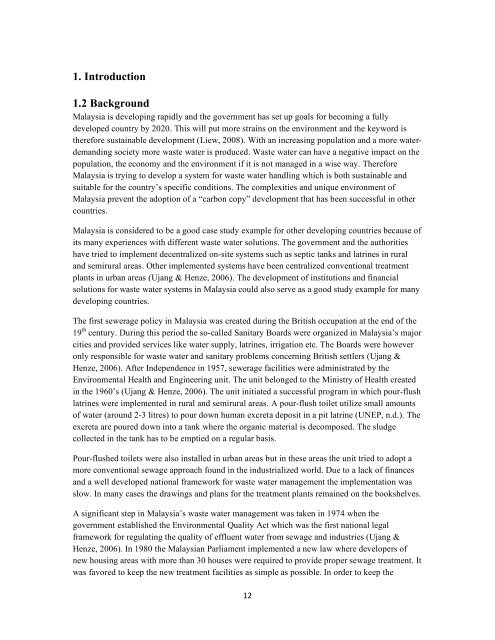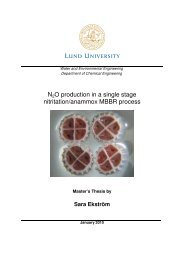Alexander Szabo and Oscar Engle - Svenskt Vatten
Alexander Szabo and Oscar Engle - Svenskt Vatten
Alexander Szabo and Oscar Engle - Svenskt Vatten
You also want an ePaper? Increase the reach of your titles
YUMPU automatically turns print PDFs into web optimized ePapers that Google loves.
1. Introduction<br />
1.2 Background<br />
Malaysia is developing rapidly <strong>and</strong> the government has set up goals for becoming a fully<br />
developed country by 2020. This will put more strains on the environment <strong>and</strong> the keyword is<br />
therefore sustainable development (Liew, 2008). With an increasing population <strong>and</strong> a more waterdem<strong>and</strong>ing<br />
society more waste water is produced. Waste water can have a negative impact on the<br />
population, the economy <strong>and</strong> the environment if it is not managed in a wise way. Therefore<br />
Malaysia is trying to develop a system for waste water h<strong>and</strong>ling which is both sustainable <strong>and</strong><br />
suitable for the country’s specific conditions. The complexities <strong>and</strong> unique environment of<br />
Malaysia prevent the adoption of a “carbon copy” development that has been successful in other<br />
countries.<br />
Malaysia is considered to be a good case study example for other developing countries because of<br />
its many experiences with different waste water solutions. The government <strong>and</strong> the authorities<br />
have tried to implement decentralized on-site systems such as septic tanks <strong>and</strong> latrines in rural<br />
<strong>and</strong> semirural areas. Other implemented systems have been centralized conventional treatment<br />
plants in urban areas (Ujang & Henze, 2006). The development of institutions <strong>and</strong> financial<br />
solutions for waste water systems in Malaysia could also serve as a good study example for many<br />
developing countries.<br />
The first sewerage policy in Malaysia was created during the British occupation at the end of the<br />
19 th century. During this period the so-called Sanitary Boards were organized in Malaysia’s major<br />
cities <strong>and</strong> provided services like water supply, latrines, irrigation etc. The Boards were however<br />
only responsible for waste water <strong>and</strong> sanitary problems concerning British settlers (Ujang &<br />
Henze, 2006). After Independence in 1957, sewerage facilities were administrated by the<br />
Environmental Health <strong>and</strong> Engineering unit. The unit belonged to the Ministry of Health created<br />
in the 1960’s (Ujang & Henze, 2006). The unit initiated a successful program in which pour-flush<br />
latrines were implemented in rural <strong>and</strong> semirural areas. A pour-flush toilet utilize small amounts<br />
of water (around 2-3 litres) to pour down human excreta deposit in a pit latrine (UNEP, n.d.). The<br />
excreta are poured down into a tank where the organic material is decomposed. The sludge<br />
collected in the tank has to be emptied on a regular basis.<br />
Pour-flushed toilets were also installed in urban areas but in these areas the unit tried to adopt a<br />
more conventional sewage approach found in the industrialized world. Due to a lack of finances<br />
<strong>and</strong> a well developed national framework for waste water management the implementation was<br />
slow. In many cases the drawings <strong>and</strong> plans for the treatment plants remained on the bookshelves.<br />
A significant step in Malaysia’s waste water management was taken in 1974 when the<br />
government established the Environmental Quality Act which was the first national legal<br />
framework for regulating the quality of effluent water from sewage <strong>and</strong> industries (Ujang &<br />
Henze, 2006). In 1980 the Malaysian Parliament implemented a new law where developers of<br />
new housing areas with more than 30 houses were required to provide proper sewage treatment. It<br />
was favored to keep the new treatment facilities as simple as possible. In order to keep the<br />
<br />
12















